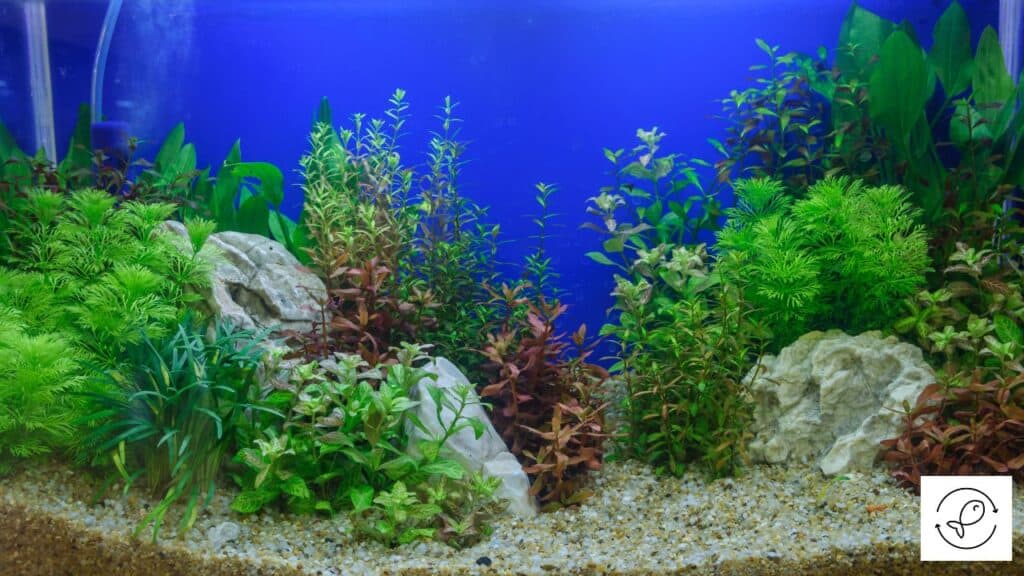Live plants can make your fish tank look more realistic. There are many types of plants you can use.
Don’t be scared to try different plants to find out what you like most. When buying, remember to choose plants that can survive in your tank’s conditions and won’t disturb your fish.
Also, avoid filling your tank completely with plants. This can stress your fish and make them sick.
A good tank setup should have a mix of different plants and free spaces.
Live aquarium plants can be broadly classified into 3 types:
- Foreground Plants,
- Midwater Plants, and
- Floating Plants.
Foreground Plants
Foreground plants are small plants that are placed in the front and center of your aquarium.
They are important because they make your tank look more interesting and not just filled with plants all around the edges.
They also balance the taller plants at the back, make it easier to look into the tank, and add different types to the overall look of the aquarium. So, choosing the right ones is crucial.
1. Baby Tears
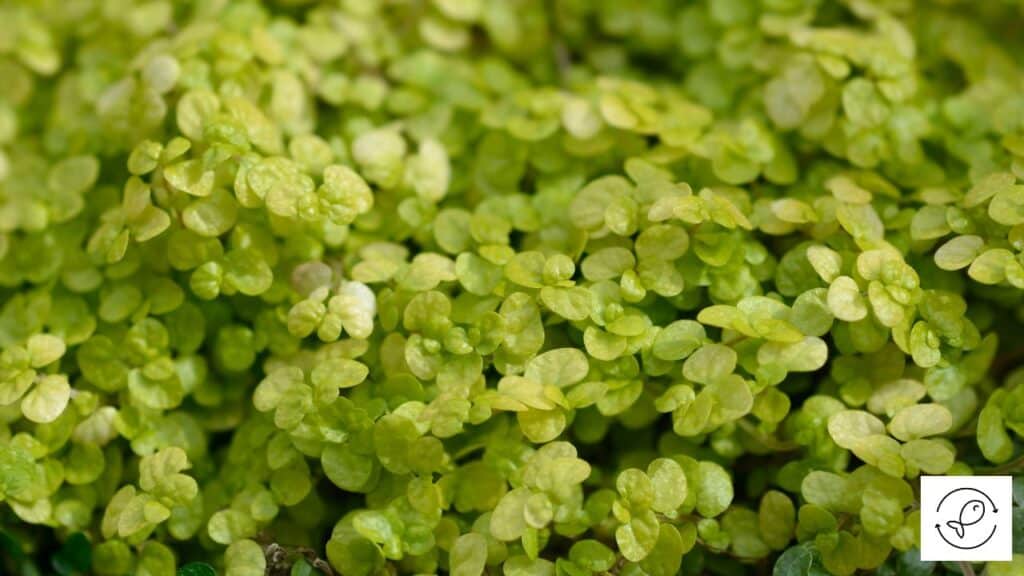
Baby Tears (Micranthemum umbrosum) is a vibrant, fast-growing plant, perfect for large aquariums over 30 gallons.
It grows rapidly and needs regular trimming to prevent overgrowth. It’s also a good choice if you have fish that tend to eat plants, as most fish species don’t like how baby tears taste.
It’s a tough plant that tolerates beginners’ errors. The plant has tiny clusters of light green, round leaves that resemble a baby’s tear, hence the name.
It grows better with added carbon dioxide (CO2), but it can also survive without it.
| Level | Easy |
| Temperature | 70°F to 80°F |
| Light | Bright |
| pH | 5.5 to 7.5 |
| Placement | Foreground |
2. Brazilian Micro Sword
The Brazilian Micro Sword (Lilaeopsis brasiliensis) is a plant from South America. It looks like thick green grass.
It can become a place for algae to grow because of its thickness. If you want this plant to do well, you need to control the algae in your tank.
You can do this by pruning the thick leaves inside the plant. This allows light and water to reach all parts of the plant.
After pruning, rinse the plant in room-temperature water to remove any extra debris before putting it in your aquarium.
To stop this plant from becoming a ball, keep it in parts of the tank where water moves a lot (like near air stones or filter return water).
This plant grows slowly and does really well in fine substances like sand. Over time, your aquarium will look like it has grass growing in it.
| Level | Moderate |
| Temperature | 60°F to 79°F |
| Light | Very Bright |
| pH | 6.0 to 8.0 |
| Placement | Foreground |
3. Cryptocoryne
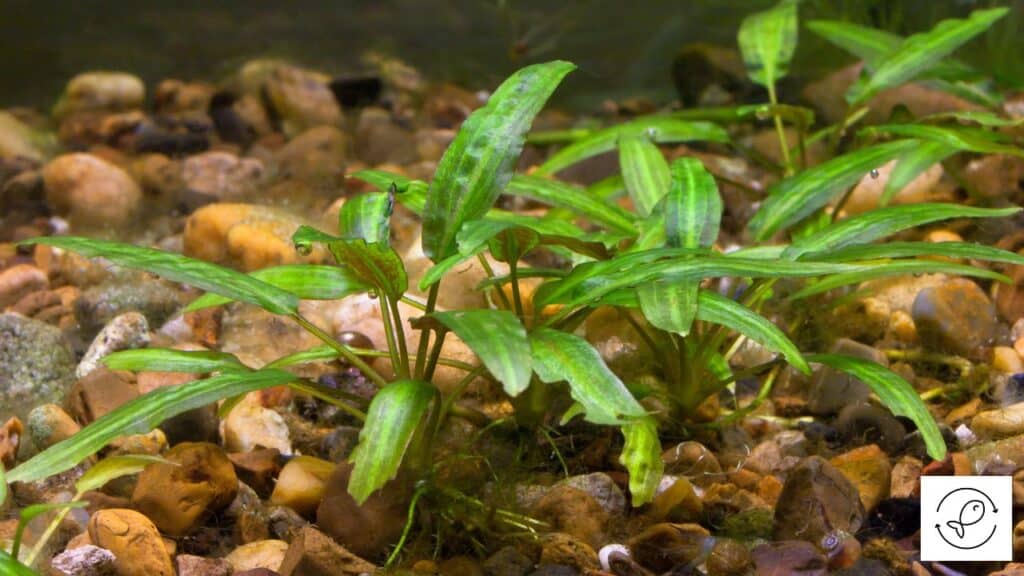
Cryptocoryne, also known as Cryptocoryne wendetti, is a beautiful plant with long leaves that look like a garden tool called a trowel.
The leaves are mostly green, but they also have red areas. This plant is perfect for tanks that have been used for a while.
In nature, it grows on the banks of rivers and attaches itself to driftwood or rocks.
For Cryptocoryne to grow properly, it needs a lot of nutrients, which is why it’s best to keep it in an older tank.
If you place it in a brand new tank without adding any plant food, it might not survive. Also, don’t worry if the plant seems to be struggling and losing leaves when you first add it to your tank.
This is normal behavior for this plant, which tends to grow slowly.
Cryptocoryne is a slow-growing, nutrient-loving plant perfect for older, well-used tanks.
| Level | Medium hard |
| Temperature | 70°F to 80°F |
| Light | Bright |
| pH | 6.5 to 7.5 |
| Placement | Foreground to midrange |
4. Dwarf Anubias
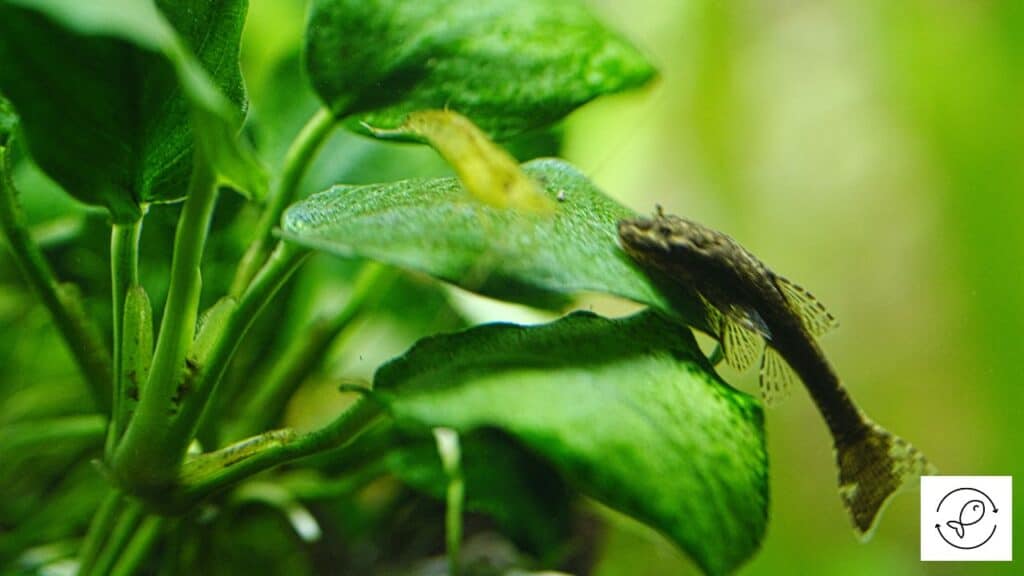
Dwarf Anubias, also known as Anubias nana, is a great plant for beginners. This is because it grows well even when the water conditions are not perfect.
This plant grows slowly and has big, green leaves that can make any fish tank look more colorful and vibrant.
It gets its nutrients from rhizomes and likes to be tied to driftwood so that water can flow around it. It doesn’t need to be buried in gravel.
However, you should avoid keeping this plant under direct sunlight or bright artificial lights.
| Level | Easy |
| Temperature | 59°F to 79°F |
| Light | Low |
| pH | 5.5 to 6.8 |
| Placement | Foreground to midrange on driftwood and rocks |
5. Dwarf Four-leaf Clover
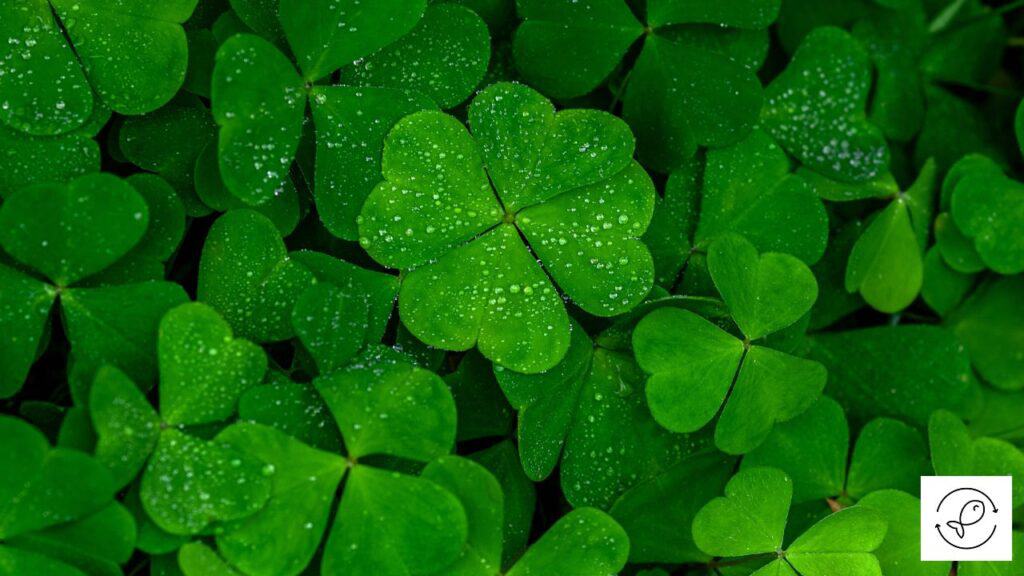
The Dwarf Four-leaf Clover, also known as Marsilia hirsute, is a plant that looks like a mini four-leaf clover.
It’s a kind of plant that spreads out and forms a dense, carpet-like layer. The plant needs a lot of light to grow. The smaller type of this plant only gets to about 2 inches tall.
The regular kind can grow up to 8 inches tall. You can make more plants by taking the young ones that start to grow from the main plant, separating them at the roots, and planting them on their own.
| Level | Easy |
| Temperature | 68°F to 84°F |
| Light | Low |
| pH | 6.2 to 7.5 |
| Placement | Midlevel |
6. Java Moss
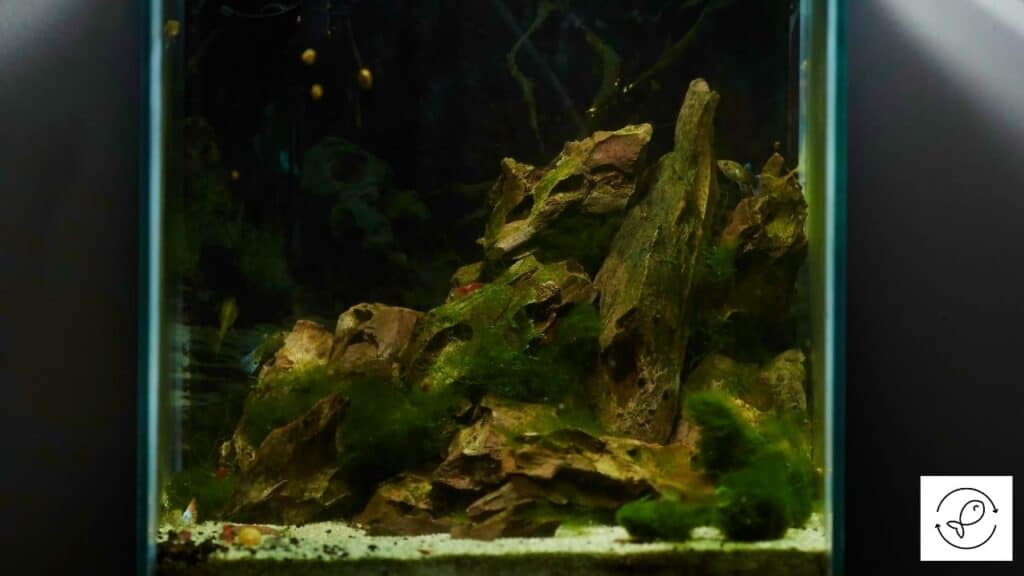
Java moss is a type of plant that grows in water and is often found in aquariums. It sticks to things like rocks, wood, and plant roots.
It’s pretty easy to look after and can grow in most water conditions. It’s a good plant for baby fish to hide in to stay safe from bigger fish.
| Level | Easy |
| Temperature | 60°F to 86°F |
| Light | Low to High |
| pH | 5.0 to 8.0 |
| Placement | Base layer over bottom |
7. Madagascar Lace
The Madagascar Lace Plant, also known as Aponogeton fenestralis, is a unique aquatic plant with dark green leaves that resemble a lace tablecloth.
It’s really interesting to see this plant move with the gentle flow of water. However, you should know that algae often get stuck in the leaf patterns.
So, having fish or other creatures that eat algae in your tank will help keep the plant healthy.
As this plant grows taller, you can move it to the back of your aquarium. It’s not a difficult plant to care for.
| Level | Easy |
| Temperature | 60°F to 75°F |
| Light | Very Bright |
| pH | 5.5 to 6.8 |
| Placement | Foreground to midrange |
8. Pearl Grass
Pearl grass, also known as Hemianthus micranthemoides, is a simple, light green plant perfect for the base of your fish tank.
It has leaves shaped like half an oval. As it grows, it sprouts side branches in all directions.
Trimming this plant helps it grow more and cover any empty spots. It’s not too hard to take care of.
| Level | Easy |
| Temperature | 68°F to 82°F |
| Light | Medium to bright |
| pH | 5.0 to 7.5 |
| Placement | Foreground |
Midwater Plants
Midwater plants are a type of aquatic plant that you put in the middle area of your fish tank.
You can also mix them in front of bigger plants at the back of the tank. They’re good for beginners.
These plants help create a pleasing environment for the tank’s inhabitants and also for those viewing the aquarium.
9. Aquatic Banana Plant
The Aquatic Banana Plant is a simple water plant named after its banana-like roots.
It’s easy to care for, and it can thrive in different light and water situations. In other words, it’s a plant that looks like a banana and lives in water.
It doesn’t need special light or water to grow well. It’s named after its roots because they look like bananas.
| Level | Easy to Medium |
| Temperature | 70-82 degree F |
| Light | Moderate |
| pH | 6.0-7.5 |
| Placement | Mid-level or floting |
10. Coffeefolia
Coffeefolia, also known as Anubis barteri, is a plant with thick, wavy leaves. When young, its leaves are reddish-brown, but they turn green as it grows.
To keep it healthy, you need to give it iron supplements and plant it in gravel that feels like rocks.
If you have fish that like to nibble on plants, this would be a good choice, because most fish don’t bother it.
| Level | Medium |
| Temperature | 68-86 degree F |
| Light | Medium |
| pH | 5.5-9.0 |
| Placement | Middle of tank |
11. Dwarf Sagittaria
Dwarf Sagittaria is a type of plant with long, thin leaves that is really tough. For it to grow well, it needs iron supplements and a moderate amount of light.
But, if it gets too much light, its leaves will turn red. You can grow more of this plant by using its runners. If you do this right, you’ll end up with a look that’s like a green carpet.
| Level | Easy |
| Temperature | 72-82 degree F |
| Light | Moderate to strong |
| pH | 6.5-7.5 |
| Placement | Middle of tank |
12. Water Wisteria
Water wisteria, which comes from India and Nepal, loves extra CO2 in its water. In the wild, it tends to float, so when you put it in your aquarium, make sure it’s properly anchored.
Be careful which fish you put it with – if they like to nibble on plants, they could damage it.
| Level | Easy |
| Temperature | 72-82 degree F |
| Light | Moderate to strong |
| pH | 6.5-7.5 |
| Placement | Mid to rear of tank |
Background Plants
Background plants can make your aquarium look more complete. They are usually placed at the back of the tank and can hide things like filter tubes, heaters, and air pumps.
They can also be placed in the front corners for a unique look. Try out different types of background plants to see which ones you like the most.
13. Amazon Sword
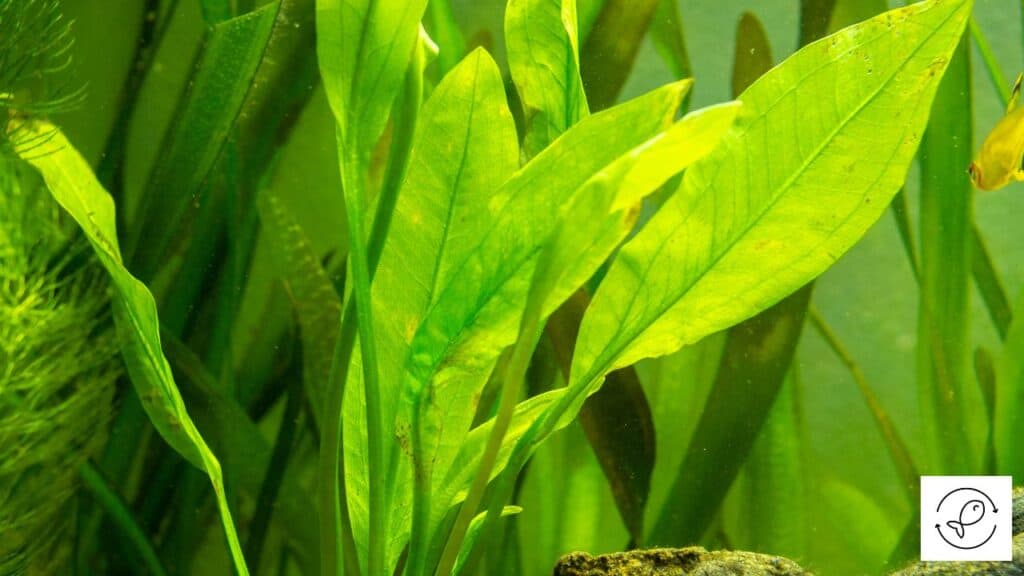
The Amazon Sword plant, named for its natural habitat in the Amazon and its sword-like leaves, is a great centerpiece for your plant arrangement.
It can bloom beautifully, especially if the blooms are above the water. However, it needs extra CO2 and fertilizer to thrive. Beware of its large roots, as they can overtake other plants.
| Level | Moderate |
| Temperature | 72°F to 82°F |
| Light | Medium to bright |
| pH | 6.4 to 7.2 |
| Placement | Midrange to background |
14. Carolina Fanwort
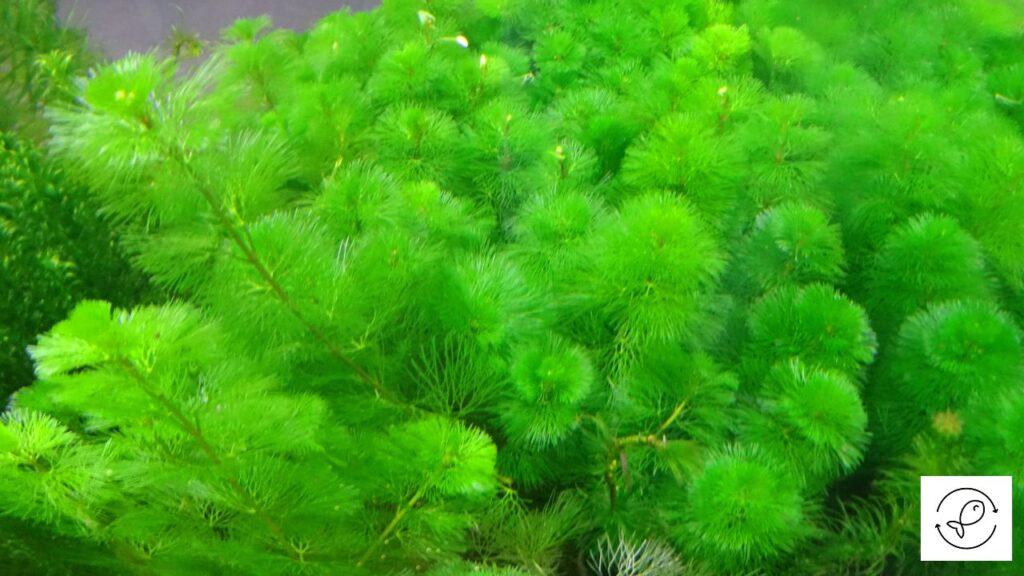
The Carolina Fanwort is a lovely light green plant that looks feathery. It’s perfect for covering up unwanted spots in the background of your tank, and fish love to snack on it.
However, its leaves fall off easily and this can cause a mess in your tank and even block your filters. It’s a plant that grows quickly and prefers soft, acidic water.
It looks best when you plant several together, at least three. But be warned, you’ll need plenty of gravel to hold it down because it tends to float up often.
| Level | Moderate |
| Temperature | 75°F to 82°F |
| Light | Very bright |
| pH | 4.0 to 7.0 |
| Placement | Background |
15. Corkscrew Val
Corkscrew Val is an interesting, fast-growing plant from Asia. It stands out because it looks like a corkscrew and moves beautifully in water.
It can be a little hard to take care of when it’s small. So, try to get bigger ones that have strong roots.
| Level | Moderate |
| Temperature | 59°F to 86°F |
| Light | Does well in any lighting condition |
| pH | 6.0 to 8.0 |
| Placement | Background |
16. Elodea
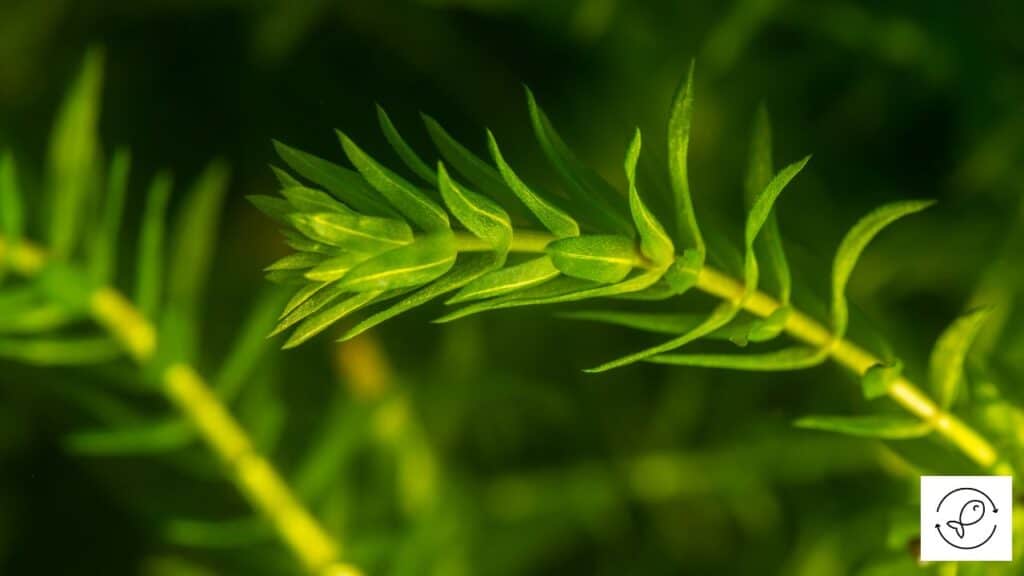
Elodea, also known as Egeria densa, is a fast-growing water plant perfect for beginners. It has special qualities that help it fight off algae growth.
When placed in bright light, it becomes thick and lush, making it ideal for filling in the back of your water garden.
The plant can float, and does a great job at getting rid of harmful nitrates in the water. It also has roots and can produce flowers when taken care of properly.
| Level | Easy |
| Temperature | 50°F to 79°F |
| Light | Bright |
| pH | 5.0 to 8.0 |
| Placement | Background |
17. Giant Anubias

Giant Anubias, also known as Anubias barteri, is a plant that grows slowly and can become up to 15 inches tall. This plant is perfect for the background of your fish tank.
It’s really hardy, with strong leaves and stems, so it’s ideal for fish like cichlids that tend to be rough with plants.
The thick part of the plant, called the rhizome, needs to sit above the gravel. This is because it sends down roots to get nutrients from the gravel at the bottom of the tank.
| Level | Easy |
| Temperature | 59°F to 79°F |
| Light | Low |
| pH | 5.5 to 6.8 |
| Placement | Background |
18. Hornwort
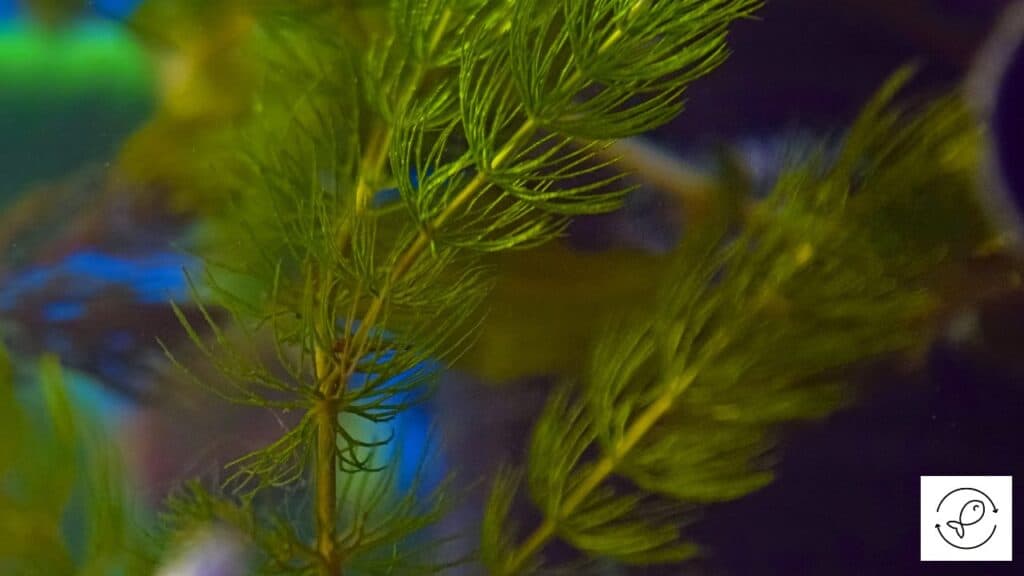
Hornwort, is a popular plant for fish tanks. It doesn’t need roots and can grow in small stones.
It grows quickly, with green, feather-like parts that point up, like an umbrella turned upside down.
Hornwort eats lots of nutrients and fights with algae by releasing a substance that harms it. It has bright green, hard leaves.
| Level | Easy |
| Temperature | 50°F to 80°F |
| Light | Does well in any lighting condition |
| pH | 6.0 to 8.0 |
| Placement | Background or floating plant |
19. Oriental Sword
The Oriental Sword, also known as Echinodorus Oriental, is a plant that grows slowly. It has wide leaves that are red and green, and they look like sword blades.
When new leaves come out, they are semi-clear and pink, which can make your fish tank look more colorful.
As the leaves get bigger, they turn red with green lines and then become wavy and fully green when they are fully grown.
These plants are good for adding a burst of color to your fish tank. Just like a chameleon changes its colors, so does this plant.
| Level | Easy |
| Temperature | 68°F to 79°F |
| Light | Bright |
| pH | 5.5 to 7.0 |
| Placement | Midrange to background |
20. Red Ludwigia
Red Ludwigia, also known as Ludwigia mullertii, is a beautiful plant known for its green leaves with a touch of red, and red stems.
As it grows, the red color can reach the leaf tips. One key feature of Ludwigia is its fast growth rate. So, even if you start with a small plant, you’ll soon have a big one.
Additionally, this plant sprouts side branches, which might require you to trim it if it becomes too bushy. It also produces very small flowers that might be hard to spot.
| Level | Easy |
| Temperature | 64°F to 77°F |
| Light | Very bright |
| pH | 4.0 to 7.0 |
| Placement | Background |
21. Red-stem Milfoil
The Red-stem Milfoil, also known as Myriophyllum matogrossensis, is a fascinating plant, easy to take care of.
Picture a winter tree without leaves, but instead of being brown, it’s red and pink. It grows densely, with three to five small leaves around its stem, much like seaweed.
You have two options with this plant – you can either anchor it to gravel or let it float.
It’s a low-maintenance plant, perfect for coldwater environments. It’s one of the best plants you can add to your collection.
| Level | Easy |
| Temperature | 60°F to 75°F |
| Light | Medium |
| pH | 6.4 to 7.2 |
| Placement | Background |
22. Stargrass
Stargrass, or Heteranthera zosterifolia, is a plant that grows quickly.
It has bright green leaves that grow in thick bunches on a lot of stems – it kind of looks like a water version of a pine tree. Because it grows so fast, you’ll need to cut it back from time to time.
Lots of water creatures like to use it to make babies.
| Level | Easy |
| Temperature | 70°F to 80°F |
| Light | Medium to bright |
| pH | 6.2 to 7.0 |
| Placement | Background |
Floating Plants
Floating plants are a key part of an aquarium. Simply put, they can help to dim the light in the tank, which is especially helpful for certain aquarium setups.
Apart from this, they also offer hiding spots for baby fish and create a more private environment for fish to mate.
Even if you don’t need to dim the lighting in your tank, adding even one floating plant can make your aquarium look more like a real-life river or pond.
So, no matter what, floating plants are a great addition to your aquarium.
23. Amazon Frogbit
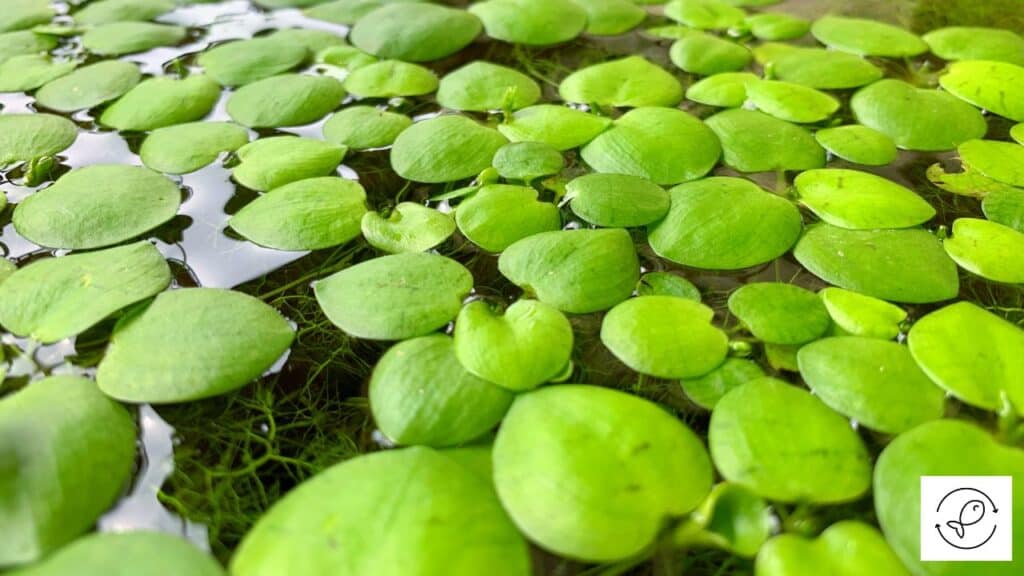
The Amazon Frogbit is a plant that grows in a circular pattern, like a rosette. It creates shoots that make a small plant at the tip.
When the tip breaks off, it turns into its own plant. The frogbit’s leaves are shiny green and look like a pond lily.
It’s a plant that floats, but its leaves can burn if they get too close to the lights in a fish tank.
| Level | Moderate |
| Temperature | 64°F to 82°F |
| Light | Medium to bright |
| pH | 6.5 to 7.5 |
| Placement | Floating |
24. Duckweed
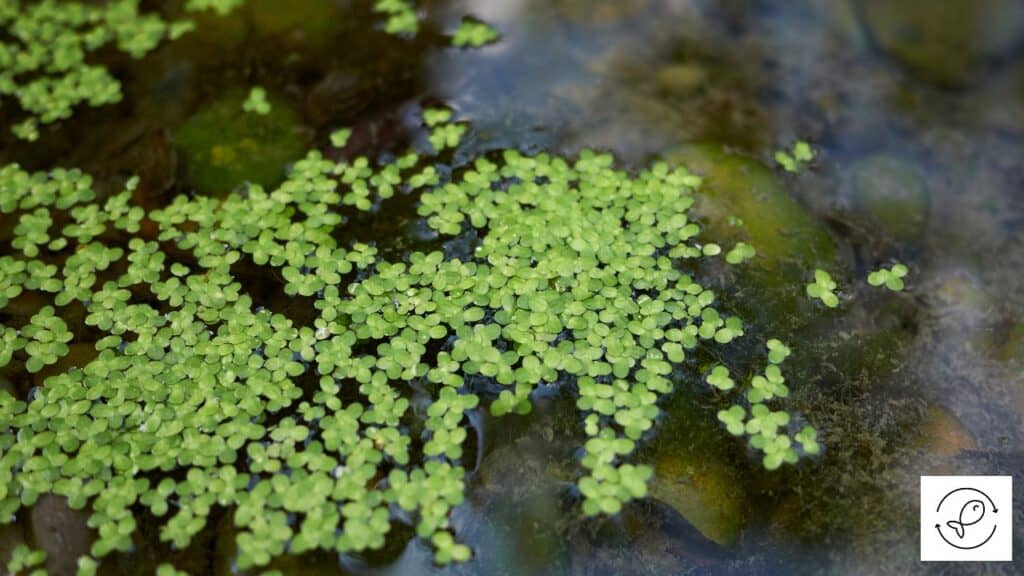
Duckweed, or Lemna minor, is a fast-growing plant that’s great for ponds. It helps block harmful sun rays that can heat the water too much or create algae.
But, it grows so fast that your pond may look dark all the time. You should only get duckweed if you have time to trim it regularly.
Duckweed has many small, oval green leaves that provide hiding places for fish and encourage them to spawn.
Many fish that live in cold water or ponds like to eat duckweed. It’s a nutritious plant because it’s packed with vitamins and minerals.
Also, duckweed benefits your pond’s water by absorbing extra nutrients and ammonia.
| Level | Easy |
| Temperature | 64°F to 79°F |
| Light | Medium to bright |
| pH | 4.5 to 7.5 |
| Placement | Floating |
Pond Plants
Pond plants are an exciting addition to any pond. They make the pond look more natural.
Here are some recommended ones for you.
Water Hyacinth
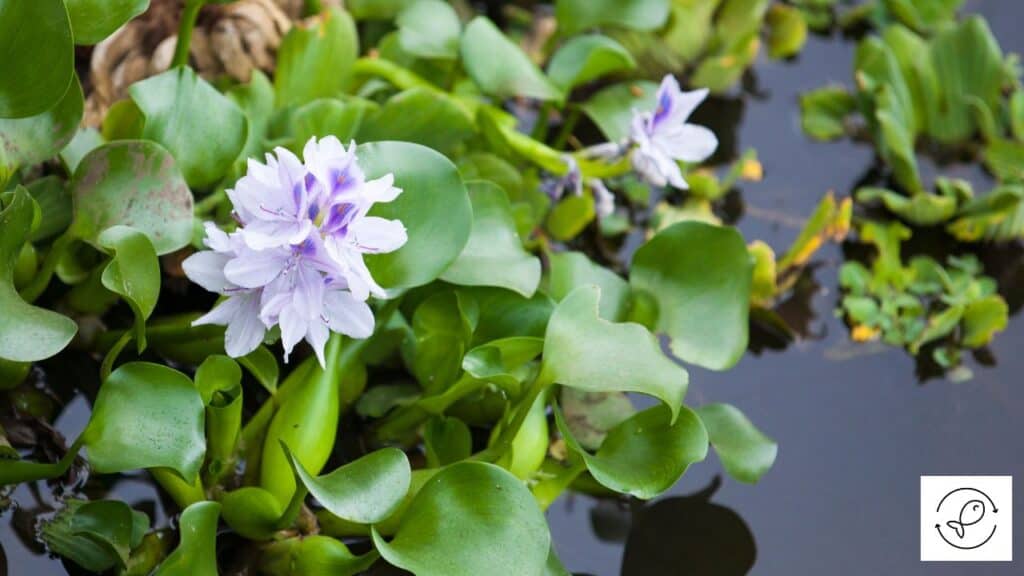
Water Hyacinth is a type of plant that grows really fast. If you don’t cut it back, it gets all tangled up. The leaves of the plant are bright green, round and shiny.
The stalk of the plant is thick and helps the plant float on the water. It also has pretty purple flowers. The plant has a large root system that fish like to eat.
But don’t worry, the roots grow back quicker than the fish can eat them.
| Level | Easy |
| Temperature | 59°F to 85°F |
| Light | Bright |
| pH | 5.5 to 8.0 |
| Placement | Floating |
Water Lettuce
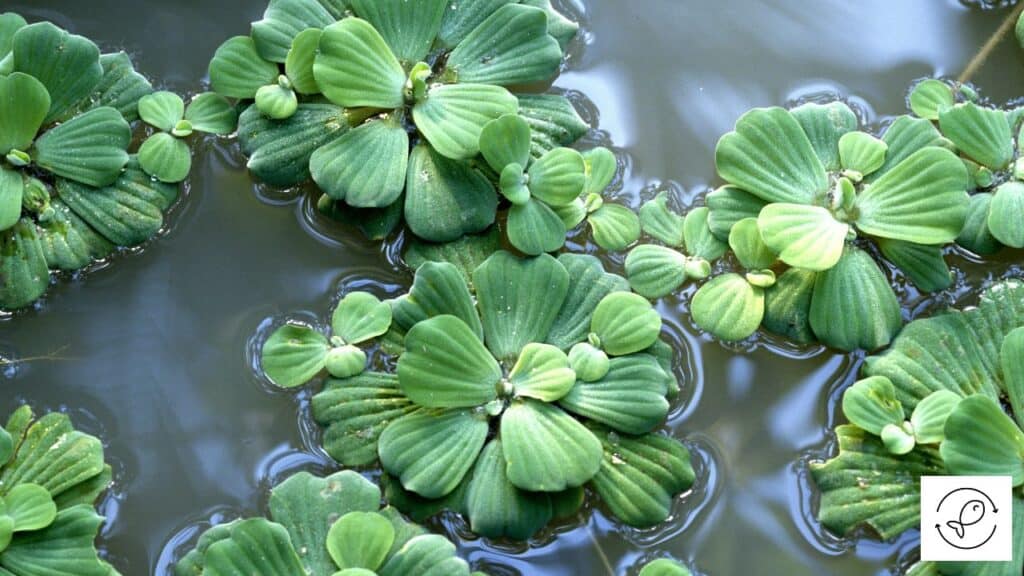
Water Lettuce, also known as Pistia stratiotes, is a type of plant with soft, green leaves that form a circular pattern.
Its long, thick roots provide a great hiding spot for fish, especially those that prefer to be near the water surface.
However, you must trim it regularly or it’ll grow too much and fill your whole fish tank or pond. This plant also helps clean the water in your aquarium.
| Level | Easy |
| Temperature | 65°F to 85°F |
| Light | Bright |
| pH | 5.0 to 8.0 |
| Placement | Floating |
Easy Live Aquarium Plants to Keep
If you’re new to gardening and feeling unsure, here’s a list of 6 simple plants you can start with.
They are easy to grow and care for, especially in freshwater environments:
- Amazon Sword (Echinodorus grandiflorus)
- Corkscrew Val (Vallisneria spiralis)
- Dwarf Swordplant (Echinodorus tenellus)
- Hornwart (Ceratophyllum demersum)
- Hairgrass (Eleocharis acicularis)
- Java Fern (Microsorium pteropus)
When you’re buying these plants, make sure to avoid any that look unhealthy.
Signs of a sick plant include lots of brown leaves, a generally poor appearance, or parts of the plant that seem transparent.
Stick to healthy-looking plants to start your gardening journey on the right foot.
Plants for Brackish Aquarium
If you’re planning to set up a brackish aquarium, which is an aquarium with salt levels between those of freshwater and seawater, you need to be careful with the plants you choose.
This is because most plants that thrive in freshwater can’t handle much salt and might not grow well or could even die in a brackish system.
Here are three plants that are good for a brackish aquarium:
- Green Cabomba (Cabomba caroliniana): This plant has soft leaves that look like feathers.
- Mangrove (Brugiuera species): You usually buy this in pots, and it can spread out all over the aquarium.
- Giant Hygrophila (Nomaphila stricta): This is a gorgeous plant that can produce a purple flower.

